The Science of Gamefish
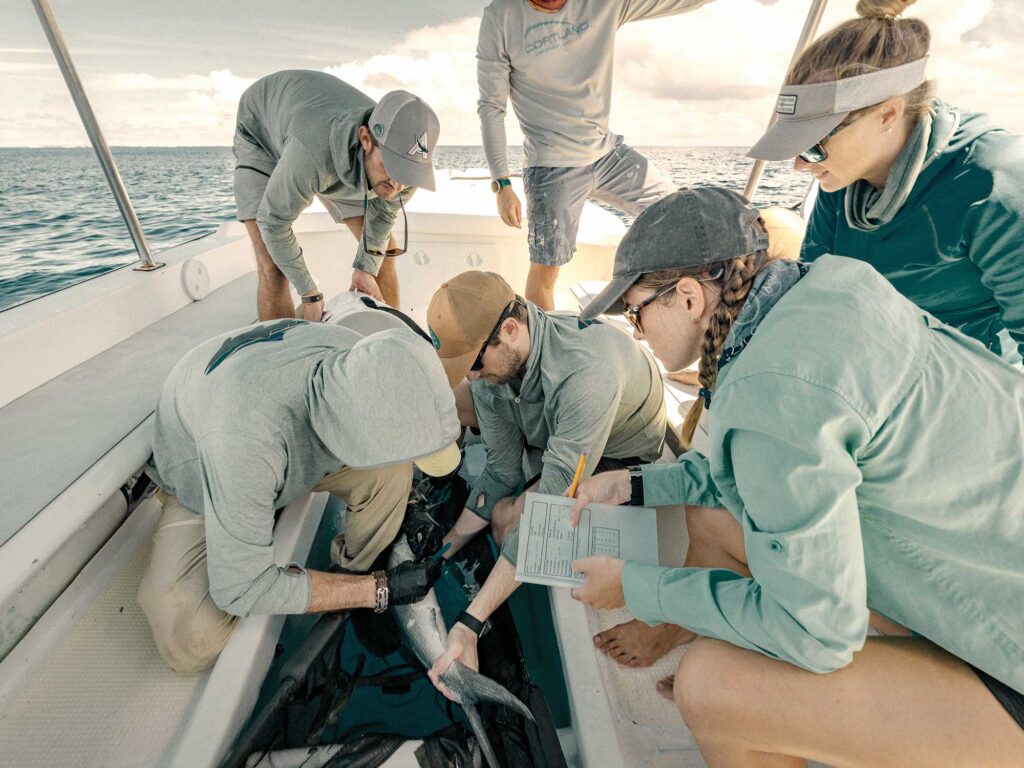 Beyond the classroom: Danylchuk and crew implant a transmitter that will help them keep an eye on this milkfish.
Courtesy Brian Chakanyuka
Beyond the classroom: Danylchuk and crew implant a transmitter that will help them keep an eye on this milkfish.
Courtesy Brian Chakanyuka
Andy Danylchuk is one of those rare scientists who knows how to speak like an angler. He can teach a complex ecological process to anyone, even those not involved in the scientific community. I first met Danylchuk at the Cheeky Schoolie Tourney on Cape Cod, where he was working with one of his grad students, Olivia Dinkelacker, to gather data on the post-release mortality of striped bass—an important topic given the current state of the fishery, where a narrow slot limit and high angler effort are resulting in a lot of fish being returned to the water.
According to Dinkelacker, the Cape Cod project aimed to “identify science-based best practices to effectively reduce impacts of recreational anglers on striped bass stocks.” She believes “this information will lead to better outcomes for each striper that’s released.”
To that end, the team was collecting data about the striper’s response to stresses, such as being held out of the water for varying amounts of time. They were fitting line-caught fish with an accelerometer, then releasing them to measure their short-term movement patterns. The goal? A better picture on how striped bass respond to the stress of capture
and handling.
At the conclusion of this project, the team hopes to give anglers the info they need to release striped bass more safely in a wide range of conditions. They’ll use this information to develop a decision tree that lets anglers make informed choices as to whether or not they can take a picture of a fish or if they should simply unhook it while it’s still in the water.
I attended an afternoon session during the tourney in which Danylchuk spoke about this project and the work he’s doing for Keep Fish Wet, a nongovernmental organization that seeks to educate anglers about best release practices. Up there in front of our group he reminded me of my college advisor, the kind of guy who knows how to hold a room, telling entertaining stories that grabbed and kept our attention. But at the end of the lecture, we had learned and retained information about some hard-to-grasp concepts. It’s this ability that makes him such an effective educator and an ambassador for the angling community.
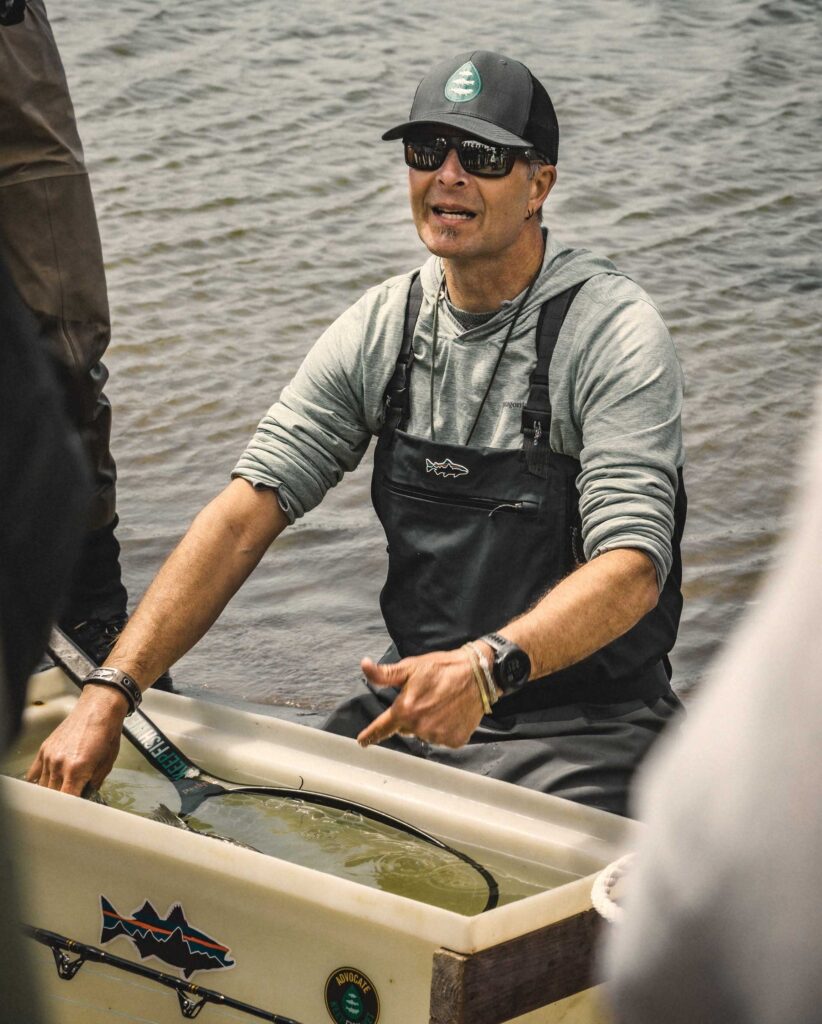 Danylchuk is an effective educator and an ambassador for the angling community.
Courtesy Andy Danylchuk
An Early Start
Danylchuk is an effective educator and an ambassador for the angling community.
Courtesy Andy Danylchuk
An Early Start
Like many who have pursued careers in fisheries, Danylchuk was drawn to the natural world early on. “I grew up watching Jacques Cousteau and remember him saying that ‘people protect what they love.’ That really stuck with me, especially as I began to fall in love with nature, and in particular fish and fishing,” he told me. His love of fishing gave him direction in his life, compelling him to focus on fish and fisheries as a career to help protect what he loves. “Apart from taking care of my family, having a career focused on fish conservation is part of my duty and purpose to give back.”
Born in Toronto, Canada, Danylchuk’s love for fishing took hold at a young age. He caught his first fish, a trout, at a relative’s pond using a hand-me-down rod with the reel held on by rubber bands. The fish pulled the reel off the rod, so he hand-lined the fish in. That powerful run hooked Danylchuk, and a lifelong obsession was born. In his teens, he fished for bass and pike in lakes north of Toronto, then snook, redfish and seatrout in Captiva Island, Florida, thanks to opportunities afforded to him by a now life-long friend.
Danylchuk attended Trent University, completing his honors thesis about marine fish in Jamaica. He returned to Trent for his masters, then went on to the University of Alberta in Edmonton, where he earned a doctorate and studied the impact of forestry on fish populations. When he learned of a position at The School for Field Studies in South Caicos he jumped at the opportunity. Soon after, he helped launch the Cape Eleuthera Institute in the Bahamas, where he studied bonefish reproduction, and how that species was affected by catch-and-release fishing. In 2009, he joined the faculty at the University of Massachusetts at Amherst, which has given him the ability to conduct research all over the globe.
With plenty of stamps on his passport, Danylchuk has chased a wide variety of species in both salt and fresh water during his career. He has a hard time playing favorites, though. He says he admires each fish’s ability to thrive in its respective environment. As a biologist, he is “greatly enamored by how each species behaves, eats, swims, migrates and reproduces.” If he had to pick a favorite, though, it would be bonefish, he says. It was the first species he caught on a fly rod, and he hooked it with a fly he tied himself. Like many who chase bones, he likes the visual aspects, watching them as they work across a flat, executing a careful stalk.
Speaking of flats, they just might be his favorite place to fish, tropical or temperate. He spent a decade living and teaching in the Bahamian Archipelago, so those islands will always have a soft spot in his heart. These days, though, he spends more time working the shallow flats of Cape Cod in pursuit of striped bass, closer to the UMass campus. He’s also dreaming of returning to the flats ecosystems in the Seychelles, as he was “completely blown away by the diversity of flats species and the pristine status of their home water” after visiting those islands in 2018. Wild places like these keep Danylchuk going, serving as inspiration to preserve the fish and habitats he loves.
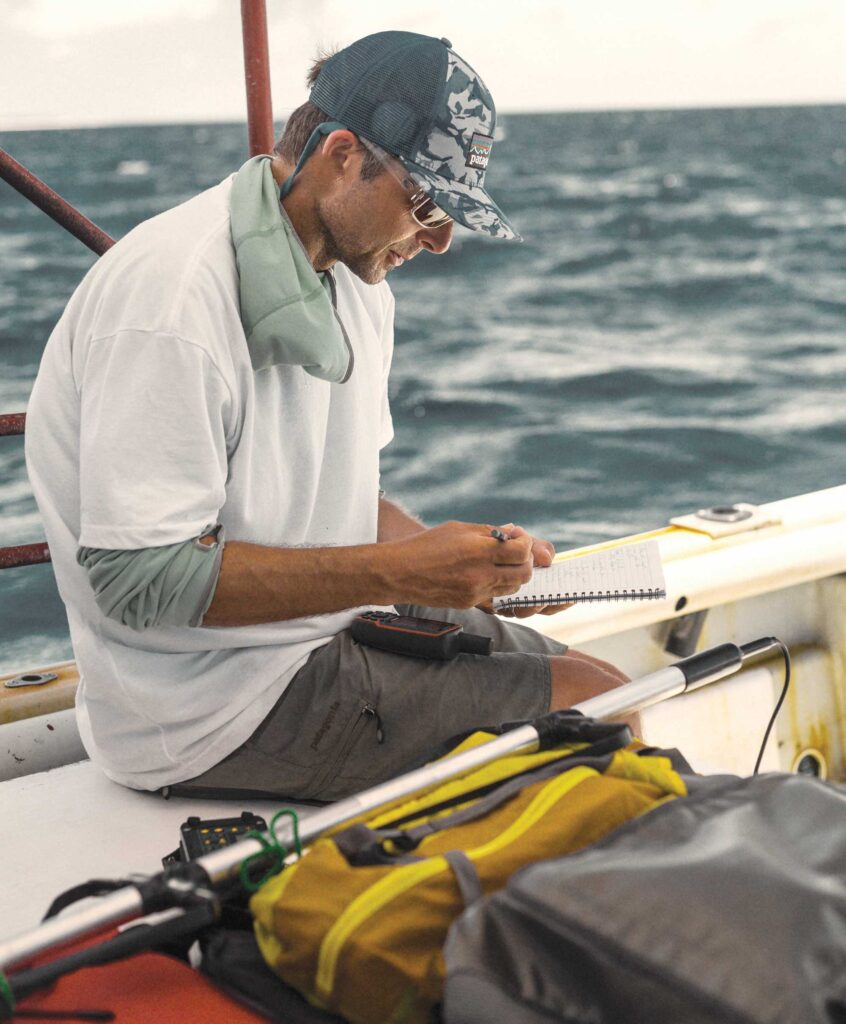 An emphasis on real-world issues drives much of the work conducted in Danylchuk’s lab.
Courtesy Andy Danylchuk
Teaching the Next Generation
An emphasis on real-world issues drives much of the work conducted in Danylchuk’s lab.
Courtesy Andy Danylchuk
Teaching the Next Generation
Danylchuk has authored or co-authored more than 200 peer-reviewed papers in scientific journals over the last 24 years. Salt Water Sportsman has reported on many of these projects in the past. He helped figure out where bonefish spawn while working with Bonefish & Tarpon Trust, studied the interactions between Atlantic tarpon and hammerhead sharks in Florida, researched giant trevally in the Seychelles, and participated in many other studies important to recreational anglers. But his students are as important to him as the science.
“I’m a strong advocate for mentoring,” he told me. “Many of my papers have my graduate students as lead authors. I’ve directly mentored over 30 graduate students and postdoctoral fellows, and each year I teach between 150 and 200 undergraduates.” He’s noticed an uptick in interest in fisheries conservation since his start at UMass. Enrollment in his sophomore-level fish conservation class has grown from 60 students when he took over in 2009 to nearly 180 students now. The hands-on nature of some of these courses is a big part of their popularity. He hopes to increase the size of the program if he receives the resources needed to effectively teach a larger brood.
“When mentoring students, I make sure to create awareness for the need to do ‘actionable science’ and fill knowledge gaps that have a broader meaning and capacity than just scientific publications as an end point,” he told me. Danylchuk doesn’t focus on theory; instead, he actively looks for answers to problems currently affecting fisheries. “Environmental change is happening too fast, and life is too short to sit back and watch our beloved recreational fisheries, their ecosystems and even the planet waste away.
“I certainly have projects that I personally would love to do, but it is more important to me that I use my capacity to address questions that are directly tied to the needs of others,” he says. This emphasis on real-world issues drives much of the work conducted in Danylchuk’s lab. Inspiration often comes from questions from recreational anglers, guides and other user groups, including nongovernmental organizations and governments. “This approach also produces wonderful collaborations and partnerships, helps with fundraising, and in the end allows the outcome of the research to be more immediately applied to fish conservation.”
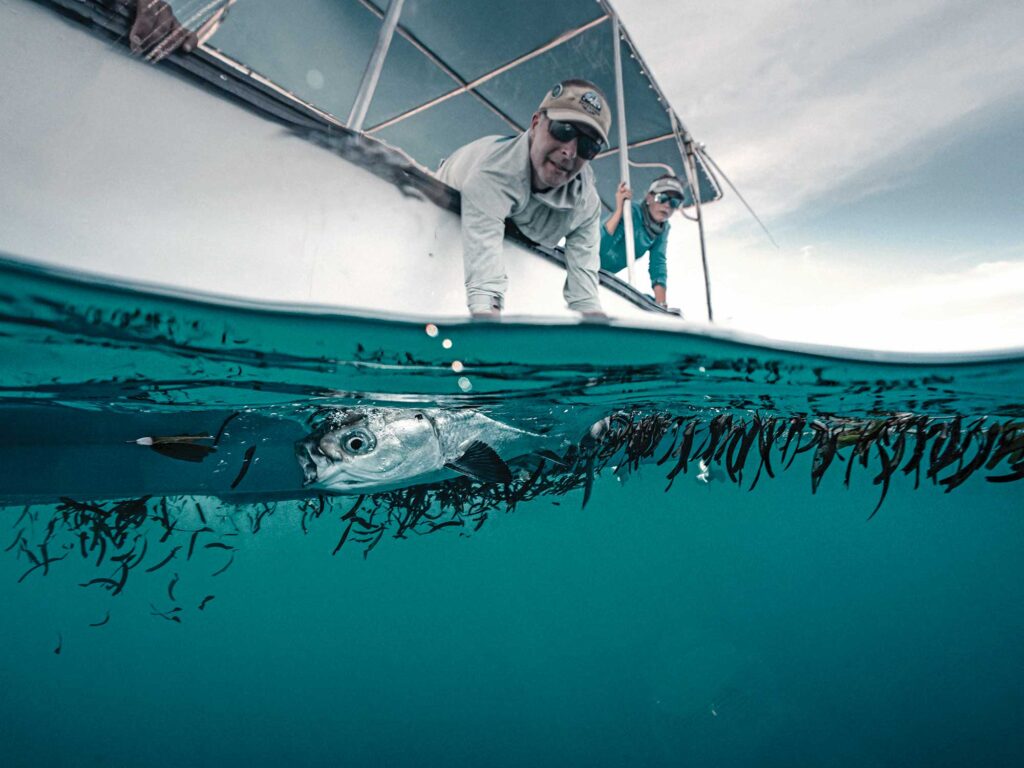 After a successful surgery, this milkfish was released to provide Danylchuk’s team valuable information about its life and habits.
Courtesy Brian Chakanyuka
The Future
After a successful surgery, this milkfish was released to provide Danylchuk’s team valuable information about its life and habits.
Courtesy Brian Chakanyuka
The Future
“It is often very hard for me to separate my love of fish and fishing from a desire to focus on their effective conservation and management,” Danylchuk told me. He believes climate change is one of the biggest challenges facing fisheries, and he is working to find solutions that allow people to continue to pursue their favorite species. He notes that the compounded effects of stressors such as climate change, habitat loss, poor handling of fish destined for release, and antiquated fisheries management all contribute to the poor resilience of gamefish stocks. To combat that, Danylchuk believes anglers can be a part of the solution by taking steps to minimize their impacts.
“We need to remember that a fishery equals fish plus people. Although our world is changing fast, I’m excited about how fisheries science is evolving to keep up with such a complex social-ecological system,” he says.
I used to work in natural-resource management, serving as a wildlife specialist for the USDA, biological science technician for the US Fish & Wildlife Service, and as a fisheries tech for the NYS DEC, among other things. One of our mantras was “Wildlife management is people management.” Danylchuk has embraced that approach to fisheries. “In less technical terms, we don’t manage fish, we manage people, and there is a much greater emphasis these days about including social science and human-dimensions research when studying recreational fisheries. I’m personally making a concerted effort to include social science in the research my lab does.”
Read Next: Brother Captains Break Record With 3,000 Dolphin Tagged and Released for Science
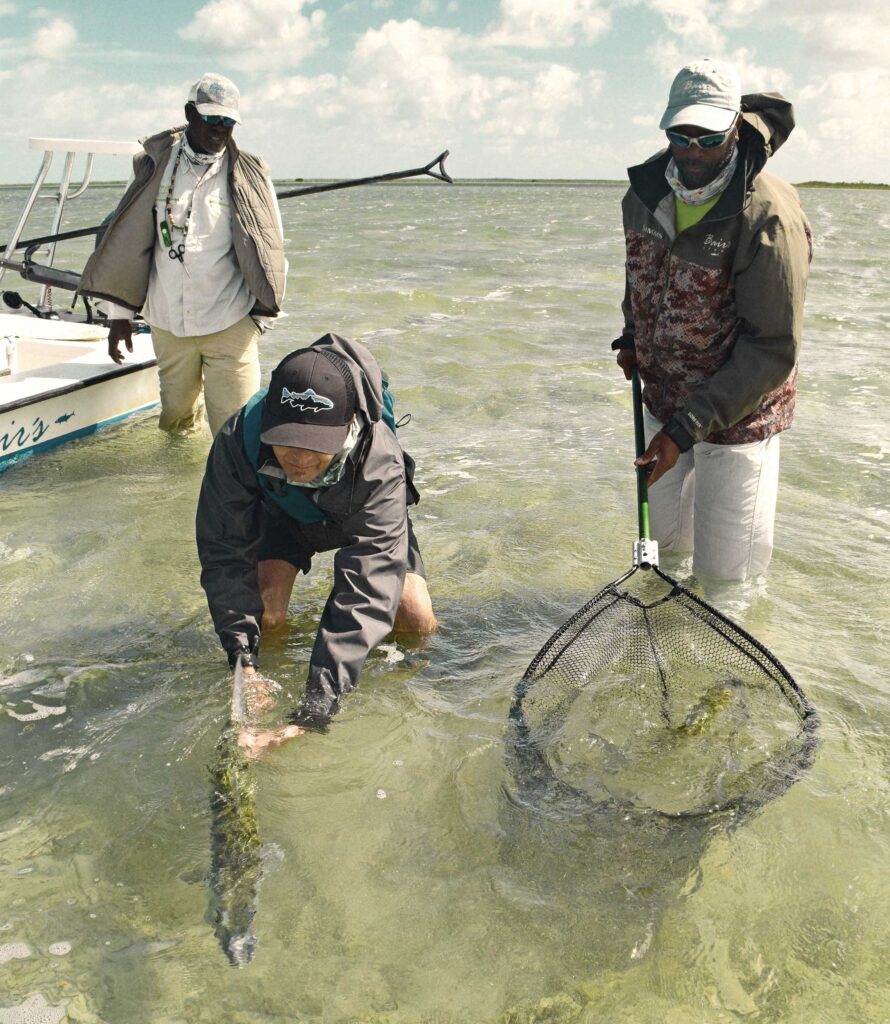 Like many anglers, it’s tough for Danylchuk to pick a favorite species. But bonefish, like this one caught and released on Andros in the
Bahamas, are pretty high up on his list. Any fish gets bonus points if it’s caught on a fly he tied himself.
Courtesy Aaron Adams
Like many anglers, it’s tough for Danylchuk to pick a favorite species. But bonefish, like this one caught and released on Andros in the
Bahamas, are pretty high up on his list. Any fish gets bonus points if it’s caught on a fly he tied himself.
Courtesy Aaron Adams
He also thinks fisheries managers should look past the “antiquated belief that there are ‘surplus’ fish available for human use because fish produce so many eggs and babies to support the maintenance of their populations.” Instead, they should take a more holistic approach that also includes taking care of the habitat the fish depend on. And all this needs to happen quickly, as Danylchuk and others in the scientific community have noted how changes in our aquatic ecosystems have been
accelerating.
The best way to accomplish all this? By training the next group of scientists to find solutions to the problems facing anglers and fish alike. “It is exciting to mentor students that are open to the idea of doing fisheries research [to apply] the results to solutions and not just sit behind paywalls in scientific journals.”
The post The Science of Gamefish appeared first on Salt Water Sportsman.
- Home
- About Us
- Write For Us / Submit Content
- Advertising And Affiliates
- Feeds And Syndication
- Contact Us
- Login
- Privacy
All Rights Reserved. Copyright , Central Coast Communications, Inc.